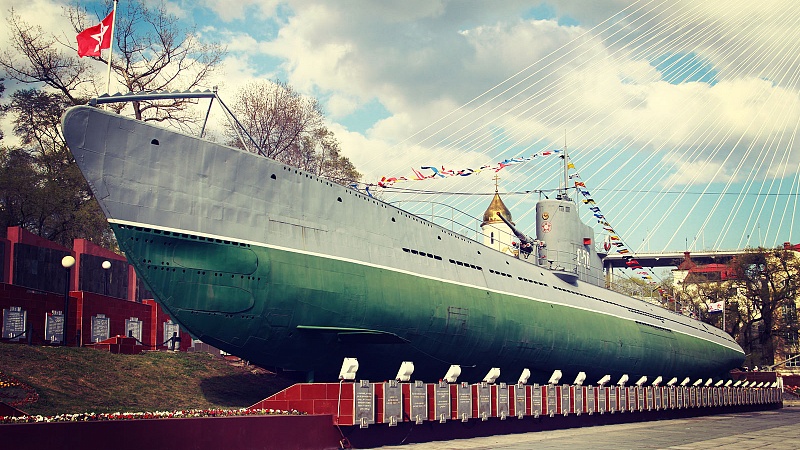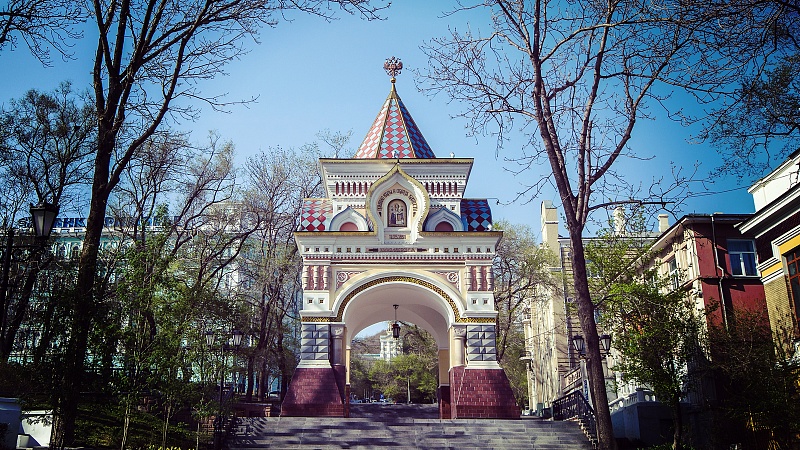WALKING IN VLADIVOSTOK
Route 1. HISTORICAL.
Each guest of Vladivostok should experience this route: fascinating, not long, but rich with impressions. The most notable monuments, which make up the city’s history are located along here. And you will follow in the footsteps of its founders, builders and defenders.
If you are traveling by train (or plane, but arrive in the city by aeroexpress train), your final stop is the railway station. Your acquaintance with Vladivostok begins here.

Try to break away from the bustling crowds of other passengers and calmly look around. And you will immediately find something to admire. For example, the building itself, the Railway Station, which was founded in 1891 in the presence of Crown Prince Nikolay Aleksandrovich, the future emperor. In the early 20th century, the station was redesigned, becoming similar to the Yaroslavl Station in Moscow, thus symbolically linking the edges of the empire.
Take a walk on the floors of the station, and look at its detail from the outside, which is fun all on its own. There are many towers, large shallow arches and columns at the entrance, and dormer windows in the form of corbel arches. Everything is done in traditional Russian architecture of the modern era, and the building resembles an old Russian palace, embellished with the representation of St. George the Conquerer on a white horse, with fairytale birds and animals.
The Vladivostok Railway Station is the last stop of the Trans-Siberian Railroad, of Russia’s Pacific Region. As evidenced by the post marked 9,288 km on the platform, this is the distance between Moscow and Vladivostok.

By the way, when exiting the train car, do not be surprised if the first thing you see is the romantic inscription: Marine Terminal. This is one of the amazing features of Vladivostok: the railway station and marine terminal are neighbors. Take the time and go into the marine terminal itself. It offers panoramic views of the Zolotoy Rog Bay and the cable suspension bridge.
And here, among the cries of seagulls, you can finally take a deep breath of sea air.

On the way back, pause on the viaduct and look at the city that stretches along the terraced hills. Perhaps the famous Soviet poet, Robert Rozhdestvensky, once looked at Vladivostok from this spot. He wrote a poem about the city called “Up and Down”:
You brush off the past…
Vladivostok is like a swing:
up and down, up and down…
Continuing our wanderings in Vladivostok, we head to one of the central streets, Aleutskaya, and continue right. The street received its name from the schooner “Aleut”, whose sailors cut through a clearing for construction of the street. This area is considered the business district of the city. Even in the 19th century, the Far East’s largest entrepreneur, Julius Briner, opened a firm here that was engaged in sea freight. He was the father of shipping in Primorye.
Now the Far Eastern Shipping Company is located in Briner’s former trading house. And next door, at 15 Aleutskaya, the manor has been preserved, in which the entrepreneur’s family lived. Future Oscar winner, Hollywood star of the fifties, Yul Brynner was born here. A monument to the actor is located in a park near his ancestral home.

After resting a bit in the cozy square, walk further along Aleutskaya towards its intersection with Svetlanskaya Street. There are several interesting things at this stage of the journey. For example, the Primorye State Art Gallery with its wonderful exhibit of European and Russian art, and the Primorye branch of the Union of Russian Artists with its exhibition hall, which presents the works of contemporary painters and graphic artists of the region.
On the left side of the street is a complex of two buildings, built in the style of Stalin’s empire, which the townspeople call the “Grey Horse.” The roof of the home on the left is decorated with Soviet symbols: a sculpture of a Red Army soldier, a miner, a pilot and a collective farmer. These homes were built at the end of the 1930s. One was intended for Far Eastern Railway employees, and the other for the NKVD, border troops, and police. The origin of the popular name for these two magnificent buildings still remains a mystery. But the name Grey Horse stuck first to the railway house, and then to the police house. Incidentally, there is a chocolate shop in one of the Grey Horse houses, where those with a sweet tooth can make a nice stop.

Upon reaching the intersection, turn right onto the main street of the city, Svetlanskaya Street, which stretches for several kilometers along the Zolotoy Rog Bay. This is Vladivostok’s grande dame, and the most historical and impressive street in the city. It received its name from the frigate Svetlana, on which Grand Duke Aleksey Romanov arrived in Vladivostok in the late 19th century.
On densely built Svetlanskaya you will find a colorful mixture of various architectural styles. For example, a Russian Orthodox church and a Protestant church. This is further evidence of history, because Vladivostok was founded not only by citizens and military from all over Russia, but also by immigrants from many countries. These were people with an entrepreneurial and adventurous streak, and they formed the urban environment, taking into account their national culture.
And so the city’s unique, international, image was created.

Leaving the town’s main square, cross it diagonally. Passing the white skyscraper from the socialist era, the Primorye Administration Building, you will find yourself face to face with a majestic monument to the Fighters for Soviet Power in the Far East. The monument was erected in 1961 and consists of two sculpture groups, figures of Red Army Soldiers and guerrillas. Between them on a high pedestal is the legendary trumpet player with a banner. A stone column stands here, erected in honor of Vladivostok being given the title “City of Military Glory.” And then, descend down the stairs to Korabelnaya Naberezhnaya.
Korabelnaya Naberezhnaya is a favorite place for residents and visitors alike. After all, this is where the construction of Vladivostok began in June 1860. Here on the wild coast, where tigers roamed freely, sailors of the military transport Manchuria landed, with orders to “occupy and strengthen the military post of Vladivostok.” A monument in the form of the Manchuria’s bow sits right on the waterfront.
Pacific Fleet warships, which are always at the pier, are a reminder of the modern military power of the Far Eastern region. The command headquarters for the Pacific Fleet Navy forces and ships is across from the warships, for those at base and at sea.

Korabelnaya Naberezhnaya is filled with the most unusual monuments. There is the Krasny Vimpel (Red Pennant) ship-museum in memory of the first submarine crews of the Pacific Fleet, the memorial complex in honor of those killed in World War II, and St. Andrew’s Chapel.
But one of the most rare is the S-56 Submarine. It was placed in 1975 to commemorate the 30th anniversary of the Great Victory. During the war, the S-56 became the most effective of all the Soviet Union’s submarines, and also the first in history to circumnavigate the globe. Which is another heroic feat entirely. Be sure to look inside the boat. Learning about the life of World War II Soviet submariners will entice both children and adults.

Korabelnaya Naberezhnaya offers beautiful views of the Zolotoy Bridge and the Zolotoy Rog Bay (Golden Horn Bay). The Governor-General of Eastern Siberia, Count N. N. Muraveyev Amursky, named the bay, comparing it with the eponymous bay in Istanbul. Bypassing the Peter the Great Gulf in 1859, which he also named in honor of the father of the Russian fleet, the Count ordered the founding of a military post here, commanding: “From here the East will be governed.” And Vladivostok, the pearl of Russia’s Pacific coast, arose.
When the city was only 30 years old, it was visited by future emperor of Russia Nikolay II, with Crown Prince Nikolay Romanov, then twenty-three, as previously mentioned. In honor of his visit the Arch of the Crown Prince was built, also called the Nikolaevsky Triumphal Arch. In 1927, the arch was blown up, destroying any reminder of the tsarist regime. Today, a replica of the former Arch of the Crown Prince, which was rebuilt in 2003, decorates the square next to the submarine.

After admiring the arch and relaxing in Admiralsky Square, ascend back to Svetlanskaya Street and turn left. Along the way you will come across some stylish shopping centers and cafes. Svetlanskaya Street has always been famous for its trendy establishments.
Here, the main post office building built in the neo-Russian style, comes into sight. Nearby is the sculpture of a woman who is in a hurry to drop a letter into the mailbox. This is American Eleanor Pray, famous today in Vladivostok, who lived here for more than 30 years at the turn of the century, leaving only in 1930. In her letters to relatives in America and China, which have been published in several books along with her own photographs, she wrote about the city’s life for decades, creating its chronicle. She is even called Vladivostok’s first blogger.

After becoming acquainted with Eleanor Pray, walk further down Svetlanskaya Street to her favorite store, which was then was called “Kunst and Albers Trading House” and is now referred to as GUM. The building, constructed in a modern style with elements of German Baroque, over a hundred years ago was the decoration of the main street. In addition to steam heating, telephones, elevators and other frills, this was the first place in Siberia and the Far East to have electric lights.
Take a walk through the stores of GUM, and when you tire, look inside cafe Dushenka, whose interior design returns you to the days of Eleanor Pray. In the cafe, sharing impressions of the trip and watching the city life through the window, you can have a cup of coffee with some home-baked treats.
If you liked this article, share it with friends:
Come to Vladivostok!
We recommend
Tourist Attractions

Old GUM Courtyard
Bread and jams in the courtyard of one of the most beautiful historic buildings in Vladivostok, where the "free port" spirit meets the creative energy of urban youth.

Jet Capsule
This excursion boat came to Vladivostok from Italian shipyard, not from the future. The second one in the world belongs to The Prince of Monaco. But in our city Jet Capsule ride is available for everyone!
